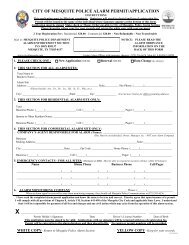airport/documents/Mesquite Master Plan Final.pdf - The City of ...
airport/documents/Mesquite Master Plan Final.pdf - The City of ...
airport/documents/Mesquite Master Plan Final.pdf - The City of ...
You also want an ePaper? Increase the reach of your titles
YUMPU automatically turns print PDFs into web optimized ePapers that Google loves.
Airport has shown that when the initial<br />
results <strong>of</strong> the formula in Table 3L are<br />
above 0.5, there is a strong possibility<br />
that the actual BCA ratio may be above<br />
1.0, as the BCA considers additional<br />
factors, not just operations, with<br />
varying degrees <strong>of</strong> weight applied. It is<br />
recommended that the <strong>City</strong> notify the<br />
FAA <strong>of</strong> its desire to be included in the<br />
ATCT program, so that an operational<br />
count and a full BCA analysis can be<br />
conducted.<br />
Initial construction <strong>of</strong> a tower is eligible<br />
for the TxDOT-Aviation Division 90/10<br />
cost sharing program, up to $1.66<br />
million. <strong>The</strong>se funds are from <strong>of</strong> the<br />
FAA AIP program which TxDOT<br />
administers as a block-grant state.<br />
Under the FAA Contract Tower<br />
Program, an updated BCA is conducted<br />
on a yearly basis. Should the BCA fall<br />
below the 1.0 ratio, then the FAA would<br />
shift to a cost-sharing program and<br />
provide operational funding equal to the<br />
calculated ratio. For example, if a BCA<br />
ratio <strong>of</strong> 0.76 results, then the <strong>airport</strong><br />
could be expected to receive funding to<br />
cover 76 percent <strong>of</strong> the operational<br />
costs. <strong>The</strong> <strong>City</strong> would then be<br />
responsible for the remaining 24<br />
percent <strong>of</strong> the annual operating costs.<br />
<strong>The</strong> Contract Tower Program was<br />
established in 1982 to provide funding<br />
for air traffic control services at lower<br />
activity level ATCTs. At contract<br />
towers, the FAA funds all or portions <strong>of</strong><br />
the cost <strong>of</strong> a qualified contractor to<br />
operate the ATCT. Initially, low-level<br />
FAA-operated towers were converted to<br />
the contract tower program. However,<br />
this program has grown to include<br />
establishing new services at <strong>airport</strong>s<br />
3-25<br />
which were previously without air<br />
traffic control services. As <strong>of</strong> 2005,<br />
there were 223 <strong>airport</strong>s in the FAA<br />
Contract Tower Program.<br />
AIRFIELD LIGHTING<br />
AND MARKING<br />
<strong>The</strong>re are a number <strong>of</strong> lighting and<br />
pavement marking aids serving pilots<br />
using the <strong>airport</strong>. <strong>The</strong>se aids assist<br />
pilots in locating the <strong>airport</strong> and<br />
runway at night or in poor visibility<br />
conditions. <strong>The</strong>y also assist in the<br />
ground movement <strong>of</strong> aircraft.<br />
Visual Approach Aids<br />
To provide pilots with visual glideslope<br />
and descent information, visual<br />
approach slope indicators (VASIs) or<br />
precision approach path indicators<br />
(PAPIs) are commonly found to the side<br />
<strong>of</strong> the runway. <strong>The</strong>se systems can<br />
consist <strong>of</strong> either a two- or four-box unit.<br />
Four-box systems are recommended for<br />
use by business jet aircraft. Currently,<br />
both ends <strong>of</strong> Runway 17-35 are served<br />
by four-box PAPIs. <strong>The</strong>se are the<br />
recommended visual descent aids and<br />
should be maintained through the<br />
planning period.<br />
In conjunction with lowering the<br />
approach minimums to Runway 17 from<br />
a three-quarter mile to one-half mile, a<br />
more sophisticated approach lighting<br />
system will be needed. <strong>The</strong> Medium<br />
Intensity Approach Lighting System<br />
with Runway Alignment Indicator<br />
Lights (MALSR) is commonly used. A<br />
MALSR is used by pilots to align the




